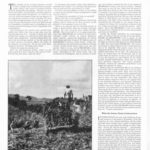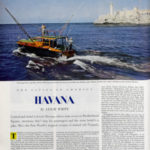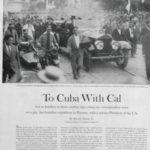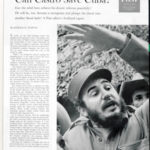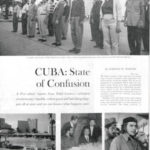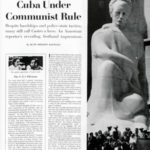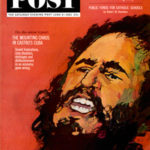The Cuban Conundrum
On Sunday, March 20, 2016, in a major step toward easing political tensions and restoring full diplomatic relations between America and Cuba, President Obama became the first sitting U.S. president to set foot on Cuban soil since 1928.
These articles from our archive give a historical perspective on the interesting and often contentious U.S.-Cuban relations, beginning with America’s entrance into the Spanish-American War and ending during the tense days of the Cuban Missile Crisis:
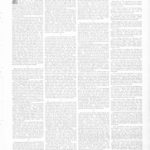
Cuba as It Is Today — March 26, 1898
Author Fanny B. Ward visits Spanish-held Havana, visits the site of the USS Maine, and meets with American Red Cross founder Clara Barton.
Cuba’s Grievances — January 27, 1934
“Our financial interest in Cuba is much greater than the average American realizes,” Edwin LeFevre warns in 1934 as America was considering stepping out of Cuba’s affairs.
Havana — March 31, 1951
Leigh White reports from pre-Castro Cuba: “Cynical and sinful is lovely Havana, where riots occur on Brotherhood Square, streetcars don’t stop for passengers and the atom bomb’s a joke. She’s the New World’s tropical version of wicked old Pompeii.”
To Cuba with Cal — February 1, 1958
Beverly Smith Jr.’s recollections of his time in Cuba, when he accompanied ex-President Coolidge, the last U.S. president to visit the island. In Smith’s report of a “simpler and more carefree era,” he recalls Will Rogers’ summation of America’s policy in the Caribbean, where Uncle Sam was “shaking with one hand and shooting with the other.”
Can Castro Save Cuba? — August 1, 1959
“For nearly seven years, in prison, in exile, and as a hunted rebel … Castro was obsessed with one thought — the overthrow of President Fulgencio Batista, whom Castro and a majority of Cubans looked upon as a thief and a tyrant,” writes Harold H. Martin, whose tone is still hopeful. At the time the article appeared in the Post, Castro had not yet nationalized American businesses in Cuba or earned the long-lasting enmity of Washington.
Cuba: State of Confusion — March 26, 1960
Harold H. Martin reports on the chaotic conditions in Cuba as Castro’s lieutenants, including National Bank director Ernesto “Che” Guevara, improvise a government.
Cuba Under Communist Rule — October 13, 1962
“Nobody can tell with any accuracy how many Cubans are for or against Castro,” writes Ruth Sheldon Knowles from Cuba in this 1962 article. “But I am convinced that he also has much popular support among farmers, workers, students, many of whom have benefited from his regime “I was surprised by the number of Cubans who spoke against the government. … But they accept it … and they see no alternative, unless there is another invasion. I was asked several times, and I was never sure whether the question was put jokingly or not, ‘When is the next Yankee invasion coming, por favor?'”
Chaos in Castro’s Cuba — June 8, 1963
In 1963, Edward Behr went looking for signs of hope in Cuba but found none. Instead of food and the promised prosperity, there was propaganda, inefficiency, and falling standards in factories and schools.
Blow-by-Blow Reporting on the Cuban Missile Crisis
Many Americans were caught by surprise when they heard President Kennedy order a military quarantine around Cuba. They were just as surprised to learn that Russia was building missile sites in Cuba, within range of the United States, and how Russia and America were challenging the other to back down or face war.
The showdown had been coming ever since Fidel Castro and his communist rebels overthrew the government of Cuba. The U.S. had strongly opposed the new regime and, in 1961, had backed an invasion of Cuba by anticommunist exiles. The invasion at the Bay of Pigs ended in complete failure. Khrushchev saw this defeat as proof of America’s inherent weakness and was emboldened to build missile bases on the island to keep the U.S. permanently on the defensive.
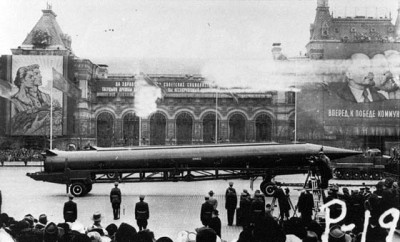
In August 1962, a team of Soviet engineers arrived in Cuba and began hurriedly constructing launchpads that would enable the Soviets to drop a thermonuclear warhead almost anywhere in the U.S. If Khrushchev could get the missile sites working quickly, the U.S. would not be able to remove them without risking nuclear attack. Khrushchev planned to repeat the operation in Europe to force Americans from their outpost in West Berlin.
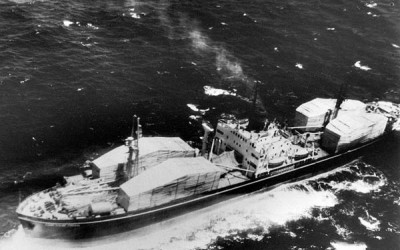
Round 1
On October 20, President Kennedy took action, announcing the U.S. would block any Soviet ships from reaching Cuba, beginning at 10:00 a.m., Wednesday, October 24.
On that morning, the Executive Committee of the National Security Council (ExComm) began its long watch for the USSR’s response. As Alsop and Bartlett address, “Reports came in which indicated that some of the Soviet ships appeared to have changed course, and that others had gone dead in the ocean. No one recalls a precise and jubilant moment when it became apparent that Khrushchev’s ships were not going to challenge the American blockade after all.” Secretary of State Dean Rusk nudged an aide and murmured “We’re eyeball to eyeball, and I think the other fellow just blinked.”
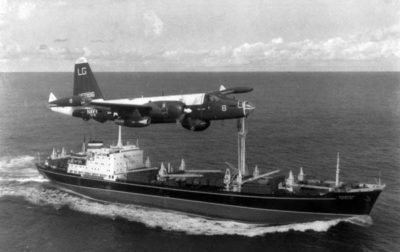
Round 2
Khrushchev might have hesitated, but he was still determined. On Friday night, he sent a letter to Kennedy that contained threats but also an appeal to be reasonable. The following day, spy planes over Cuba showed launchpad construction proceeding at full speed. In a Moscow broadcast, Khrushchev demanded that the U.S. dismantle its missiles in Turkey, which were pointed at the Soviet Union. Later that day, a U.S. spy plane was shot down with a Soviet surface-to-air missile—the first one fired from Cuba.
Khrushchev appeared to be stalling until the missiles were operational. “The next Tuesday, only three days away, was fixed as the [last] date for destroying Khrushchev’s missile and antiaircraft rockets with an air strike,” Alsop and Bartlett wrote, “clearly the next rung on the ladder to nuclear war.”
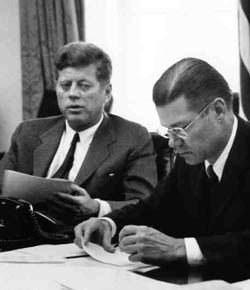
It was Robert Kennedy who came up with a way to move beyond the standoff. He suggested that the president publicly interpret Khrushchev’s Friday letter as a proposal to negotiate. President Kennedy agreed and immediately replied, explaining that the U.S. would take no action against Cuba and would end the blockade if the USSR removed its missiles.
What Alsop doesn’t report, and perhaps didn’t know at the time, was Kennedy’s secret offer to remove U.S. missile bases across the border in Turkey. With the message sent, ExComm’s meeting broke up and everyone went home that Saturday night not knowing whether the following morning would bring peace or—as millions of Americans feared—nuclear attack.
On Sunday, to everyone’s immense relief, Khrushchev agreed to the terms of Kennedy’s offer. In a Post article, written the following month, Stewart Alsop said, “This was, of course, the final, unmistakable blink. It proved once and for all that Khrushchev was not ready to go to nuclear war over Cuba.”
It was clear that war had been averted. The missiles would be dismantled. There would be no new threats to West Berlin. The threat of nuclear holocaust, which had been so close, had passed.
The entire crisis was covered in depth in the 1962 Post article “In Time of Crisis” (December 18, 1962) by Stewart Alsop and Charles Bartlett. Read the full story here.
